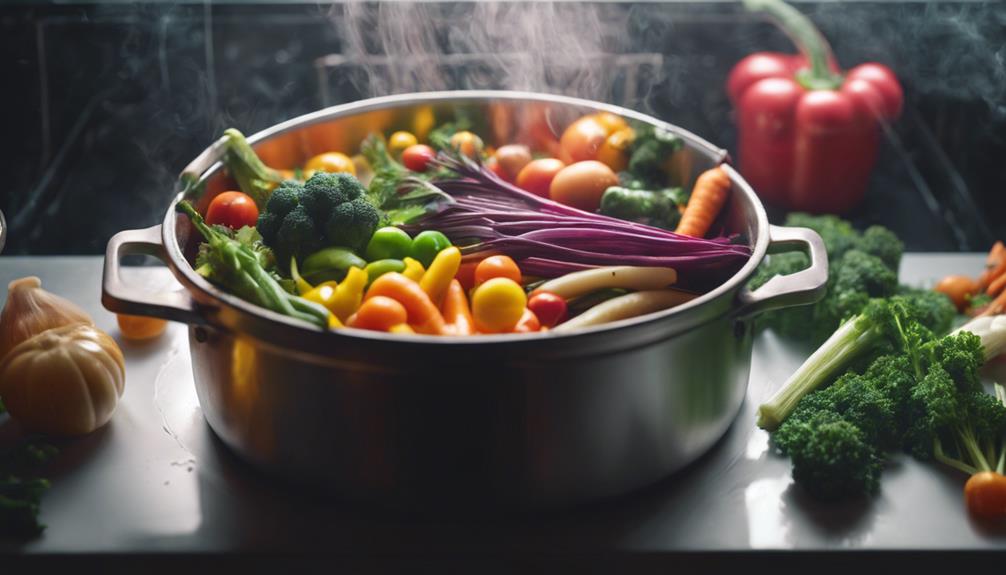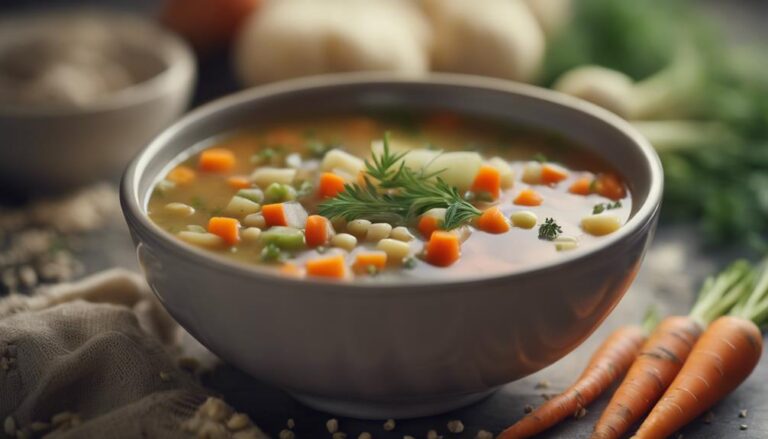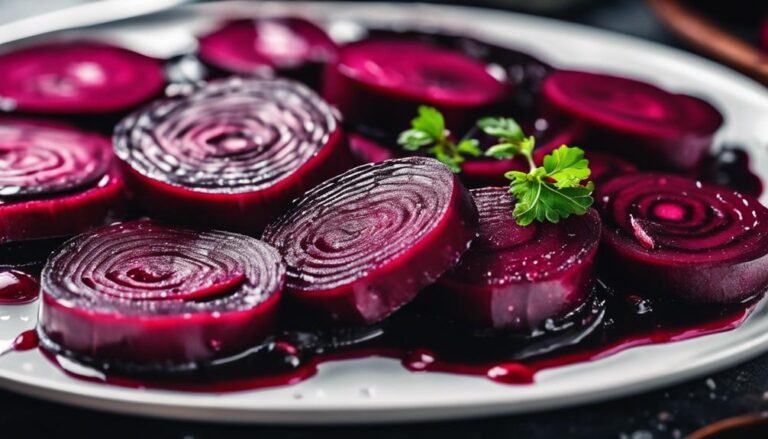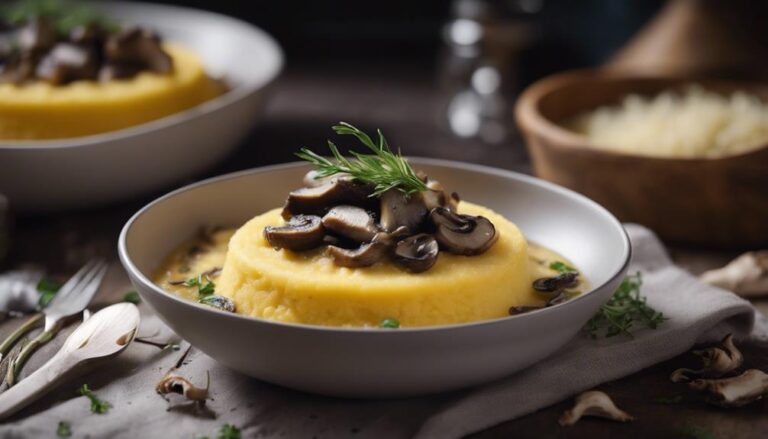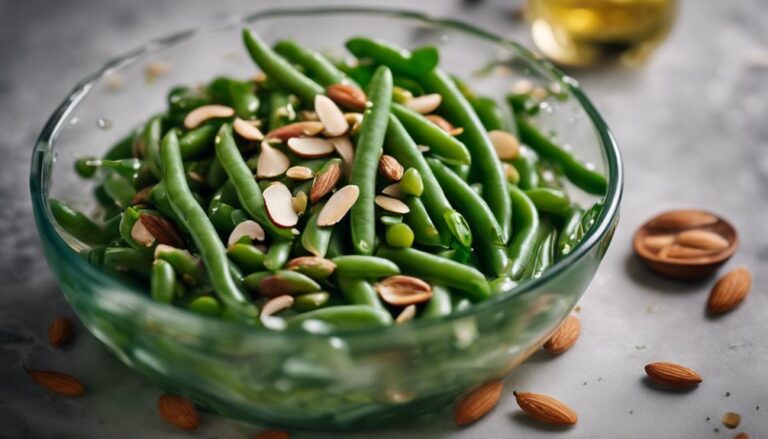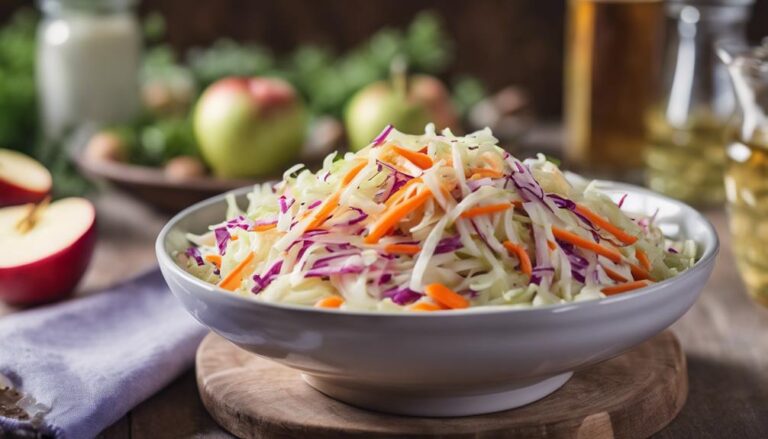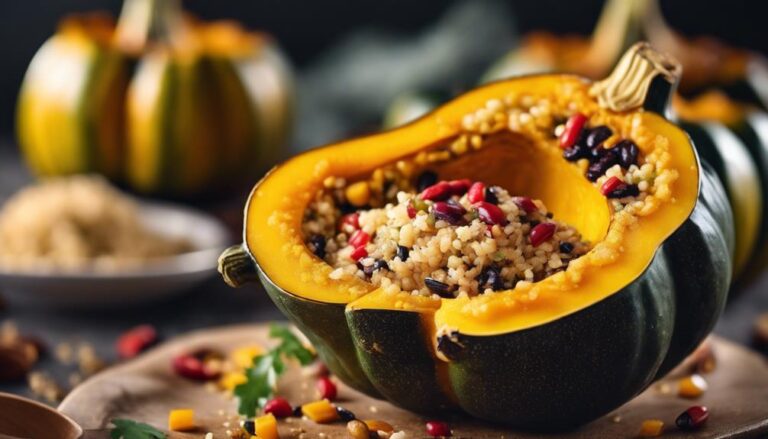Sous Vide Minestrone With Seasonal Vegetables
Create a culinary masterpiece by using sous vide to infuse seasonal vegetables into classic minestrone. Immerse vibrant veggies like zucchini, kale, and sweet potatoes in a flavorful bath. Let chicken stock deepen the base while sous vide magic keeps textures intact. Enjoy a medley of robust herbs like basil, parsley, and rosemary. These fresh additions add layers of aroma and taste. Elevate your soup with precise cooking, savoring every bite. Master the art of sous vide minestrone for a delectable experience.
What You Will Learn Here
- Sous vide cooking enhances minestrone with precise temperature control.
- Seasonal vegetables retain their individual flavors and nutrients.
- Chicken stock base adds depth to the sous vide minestrone.
- Sous vide method ensures vegetables maintain optimal texture.
- Enjoy a nutrient-rich and flavorful minestrone with sous vide cooking.
Soup's Evolution Over Time
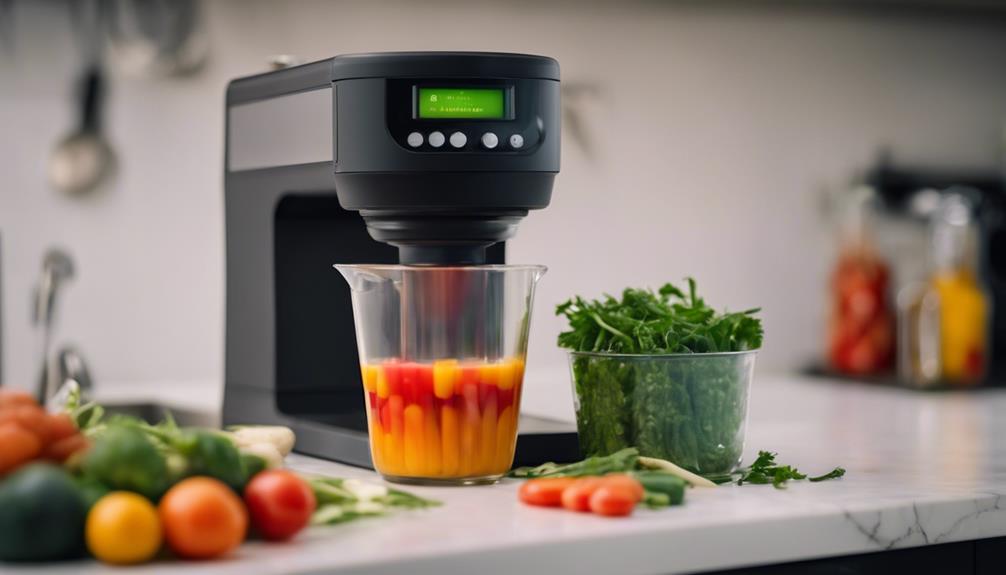
Soup's evolution over time tells a fascinating story of historical soup origins, modern ingredient variations, and cultural influences on the soup-making tradition.
From the ancient Roman kitchens to contemporary culinary scenes, minestrone soup has adapted to reflect changing tastes and culinary practices. The soup's ability to incorporate diverse seasonal vegetables and adapt to regional preferences showcases its enduring appeal and versatility.
Historical Soup Origins
Tracing back through ancient Roman and 16th-century Italian kitchens reveals the historical roots and evolution of minestrone soup, a versatile dish showcasing a variety of seasonal vegetables. Originating in Italy, minestrone has been a staple in the cucina povera tradition, emphasizing simple, nourishing ingredients.
This soup's evolution over time has allowed for creative variations and improvisation based on available ingredients. With no fixed recipe, minestrone encourages flexibility and adaptation to suit different culinary preferences.
Its history reflects a deep connection to the land and the changing seasons, making it a timeless dish that celebrates the bounties of each time of year. The evolution of minestrone highlights the enduring appeal of combining fresh, seasonal vegetables into a hearty and satisfying soup.
Modern Ingredient Variations
Exploring the evolution of minestrone soup reveals a vibrant tapestry of modern ingredient variations that have transformed this classic dish into a culinary canvas for creative experimentation. From the addition of trendy ingredients like quinoa, kale, and sweet potatoes to catering to dietary preferences such as gluten-free and vegan options, minestrone has adapted with the times.
Chefs now infuse global flavors and spices, creating fusion variations of this beloved soup. Innovative cooking techniques like sous vide have also been embraced to elevate the flavors and textures of modern minestrone recipes, offering a new twist on a traditional favorite. This evolution showcases a shift towards using fresh, seasonal vegetables and a continual exploration of diverse cooking techniques in contemporary cuisine.
Cultural Soup Influences
Have you ever wondered how cultural influences have shaped the evolution of minestrone soup over time? Minestrone, a beloved vegetable soup, has been influenced by various regions in Italy, each contributing unique ingredients and cooking tips. Let's explore the rich history behind this hearty soup through a cultural lens:
| Cultural Influences | Impact on Minestrone |
|---|---|
| Ancient Roman Kitchens | Introduced the concept of using a variety of vegetables in minestrone. |
| 16th-century Italian Kitchens | Added beans and tomatoes to the soup, enriching its flavor profile. |
| Cucina Povera Tradition | Inspired the use of simple, seasonal ingredients in traditional minestrone recipes. |
| Regional Variations | Encouraged creativity and improvisation, leading to diverse versions of minestrone across Italy. |
These cultural influences have not only shaped minestrone but also offer valuable insights and cooking techniques for preparing this classic vegetable soup.
Key Soup Components
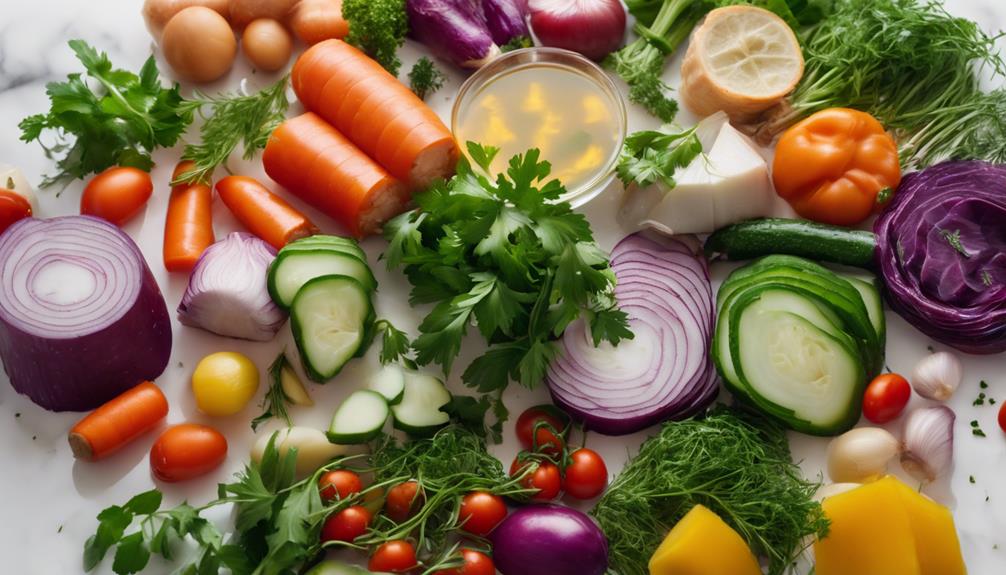
When crafting a flavorful minestrone soup, it's vital to carefully select and prepare the key components like a variety of seasonal vegetables, beans, and the choice of pasta or rice for added texture. Here are the key components to keep in mind:
- Seasonal Vegetables: Make sure that the vegetables are tender and bursting with flavor. Common choices include onions, celery, carrots, and tomatoes. These vegetables not only add depth but also bring a variety of textures to the soup.
- Beans: Beans are a staple in minestrone soup, providing protein and a hearty element. You can use a mix of beans like cannellini beans, kidney beans, or chickpeas to add richness to the dish.
- Garlic Cloves: Garlic is an important ingredient in minestrone, adding a robust and aromatic flavor. Make sure to finely chop or crush the garlic cloves to release their full potential into the soup.
- Pasta or Rice: The choice of pasta or rice can add substance and thickness to the minestrone. Opt for small pasta shapes like ditalini or small shells, or arborio rice for a creamy texture.
Top-rated Minestrone Varieties
Discover exciting variations of minestrone soup to tantalize your taste buds – from the light and invigorating Vegetarian Minestrone with zucchini, to the robust flavors of Kale and White Bean Minestrone, and the comforting warmth of Hearty Lentil Minestrone.
Each variety offers a unique blend of ingredients that cater to different palates and dietary preferences, ensuring there's a minestrone for everyone to enjoy.
Whether you prefer a vegetarian twist or a hearty meaty version, these top-rated minestrone varieties are sure to become staples in your soup repertoire.
Vegetarian Minestrone With Zucchini
Enhance your minestrone experience with the delightful addition of zucchini, a vibrant and nutritious twist to this classic Italian soup. Zucchini not only brings a light and fresh taste to the minestrone but also cooks quickly, adding a tender texture and subtle flavor. This vegetarian version of minestrone is a healthy choice, rich in vitamins and minerals, perfect for those looking for a nutritious meal. The zucchini's presence enhances the overall color and visual appeal of the minestrone, creating a vibrant and inviting dish that's sure to please your taste buds.
- Zucchini adds a fresh and light taste to the minestrone.
- It cooks quickly, maintaining a tender texture and subtle flavor.
- This vegetarian option is rich in essential vitamins and minerals.
- Zucchini enhances the visual appeal of the minestrone, making it a colorful dish.
Kale and White Bean Minestrone
Elevate your minestrone game with a nourishing and robust Kale and White Bean variation that combines the goodness of seasonal vegetables with the heartiness of fiber-rich beans. This variation of minestrone is a delightful way to enjoy a nutritious and satisfying meal. Here's why you should try it:
- Nutrient-Packed Kale: Kale, a superfood rich in vitamins, minerals, and antioxidants, adds a healthy boost to this soup.
- Protein-Rich White Beans: White beans not only contribute protein but also lend a creamy texture to the minestrone.
- Flavorful Ingredients: Carrots, celery, onions, and tomatoes come together with kale and white beans to create a flavorful and wholesome dish.
- Plant-Based Goodness: Enjoy the benefits of plant-based ingredients with this delicious kale and white bean minestrone.
Hearty Lentil Minestrone Recipe
Curious about how to prepare a top-rated Hearty Lentil Minestrone that's both nourishing and flavorful? Here are some key tips to help you craft a delicious batch of this hearty soup:
- Start with a base of lentils: Lentils aren't only rich in flavor but also provide a hearty texture and a good source of plant-based protein.
- Add seasonal vegetables: Incorporate seasonal vegetables like carrots, celery, and tomatoes to enhance the flavor and nutritional value of your minestrone.
- Simmer to perfection: Allow the lentils and vegetables to simmer together to develop a well-rounded and comforting dish.
- Enjoy in colder weather: This hearty lentil minestrone is perfect for colder days, providing warmth and satisfaction with every spoonful.
Enhancing Minestrone With Herbs
When enhancing your minestrone with herbs, choosing the right herbs can elevate the flavors to new heights.
These herbs, like basil, parsley, and rosemary, can complement the soup's taste and aroma beautifully.
Experiment with different herb combinations to create a personalized and aromatic blend that suits your preferences.
Herb Selection Tips
Enhance your minestrone soup with a selection of fresh herbs like basil, parsley, and rosemary to add depth and freshness to the dish.
These herbs not only elevate the flavor of the soup but also provide a burst of aroma that will tantalize your taste buds. Remember to add the herbs towards the end of cooking to preserve their vibrant flavors.
If fresh herbs aren't available, dried ones can be substituted, but be mindful of adjusting the quantities as dried herbs tend to be more potent.
Herb selection is subjective, so feel free to experiment with different combinations to tailor the minestrone to your liking. Finding the perfect balance of herbs will enhance the overall experience of your minestrone.
Complementing Soup Flavors
To elevate the flavor profile of your minestrone soup, consider incorporating a medley of fresh herbs such as basil, parsley, and rosemary for a delightful burst of freshness and depth. These herbs, when added at the end of cooking, preserve their flavors and aromas, providing a vibrant contrast to the hearty and rich flavors of the soup.
Basil offers a sweet, slightly peppery flavor, while parsley adds a fresh, earthy taste. Rosemary can contribute a pine-like, fragrant note to enhance the overall taste of the dish. Experimenting with different combinations and amounts of these fresh herbs can help you tailor your minestrone soup to your taste preferences, creating a harmonious blend of flavors that will delight your palate.
Garnishing Techniques
Enhancing your minestrone with a vibrant array of fresh herbs can elevate both the flavor and visual appeal of this classic soup dish. Cooking with herbs like basil, parsley, or rosemary adds a burst of taste to your minestrone, creating a fragrant and invigorating experience.
Adding chopped herbs just before serving not only enhances the flavor but also beautifies the presentation of the soup. Experimenting with different herb combinations allows you to customize the flavor profile of your minestrone, making it uniquely yours.
Final Thoughts
In conclusion, the sous vide cooking method truly elevates the minestrone soup by infusing the seasonal vegetables with robust flavors and ensuring a perfectly cooked dish. The use of chicken stock in the sous vide process adds depth to the soup's base, creating a rich foundation for the vegetables to shine.
Sous vide cooking allows each vegetable, whether it's the tender zucchini, crisp green beans, or ripe tomatoes, to retain its individual taste and texture without becoming overcooked or losing its nutritional value.
Frequently Asked Questions
What Vegetables Can You Sous Vide Together?
When sous vide cooking vegetables, you can pair similar ones like carrots and potatoes for even doneness. Consider combining hardier veggies at higher temps, like beets and parsnips, but delicate ones like asparagus and zucchini separately. Experiment with sous vide combinations for tasty results.
What Is the Best Temperature for Sous Vide Vegetables?
For your sous vide vegetables, aim for 183-185°F for best tenderness and flavor infusion. Lower temps retain color and nutrients. Varying cook times and temps provide texture control. Sous vide benefits include precise cooking.
Is It Worth It to Sous Vide Vegetables?
Sous vide benefits are definitely worth it for flavor retention and precise cooking. You'll love how it maintains nutrients and enhances taste. Try it for yourself and see the difference in your dishes!
What Is the Thickening Agent for Minestrone?
To thicken Minestrone, the starch from pasta or rice, beans, and veggies breaking down help. Some recipes add a bit of flour or cornstarch. Arrowroot powder or tapioca flour can also be used for a twist.
Conclusion
Indulge in the rich flavors of sous vide minestrone with seasonal vegetables, a dish that has evolved over time to become a beloved classic.
By focusing on key components and top-rated varieties, you can create a delicious and nutritious soup that's perfect for any occasion.
Enhance your minestrone with a variety of herbs to add depth and complexity to each spoonful.
Elevate your culinary skills with this comforting and satisfying dish. Enjoy the journey of exploring the endless possibilities of minestrone!
